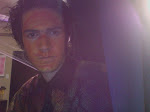Lanky: Check out this sweet solo for concert snare drum, yo.
Goofy: Kickin', but can you play it?
Lanky: Ummmm... theoretically...
Goofy was arrested in 2006 for eating Pluto. Goofy, flummoxing and slurring and hyucking all over the place, alternately claimed self-defense,and precedent from the Mayi-Mayis.
Theoretical percussion compositions may or may not be possible to play. The goal is to write something exceedingly intricate to push the boundaries of skill. If, while practicing and revising, it becomes apparent that a passage is only playable by drumming robots, the section should be revised for humans. In the end, you end up with a piece that's as hard to play as it can possibly be! Those are always the most fun. Here are some examples.

Selection from "Big Pink." This is part of a solo for concert snare drum that I wrote over the summer. Think of each line as a separate bar. Now, some of this might be making you flummox and slur and hyuck all over the place. The fifth line in particular. The hernias in this line originate from some rhythms I wrote with my guitarist extraordinaire Julian, plus a conversation I had with Bethany, my fellow komodo dragon and an Oberlin Conservatory composition major. When you see x:y over a grouping of notes, it means play x notes spaced apart as if the grouping were a y-let.
Heh? What the hell? Lanky, you indecipherable harlot! Okay, so look at the first such instance of this technique in Big Pink. The first four notes of the fifth line have "4:5" written over them. This means you should play 4 notes spaced apart as if you were playing a cinqtuplet. You basically just chop off the fifth note of your cinqtuplet. Then, the next six notes, the "6:7" grouping, should be spaced apart as if you were playing a heptuplet.
This creates horrible, horrible problems with time signatures. The main idea when I had this whole idea in the first place was about what time signatures would sound like if the bottom number wasn't a power of 2 (1, 2, 4, 8, 16...). What about 5/6? What about 3/7?
Well fuck everything, because the last bar on this page of "Big Pink" (besides the extraneous 3:5 sixteenth note grouping) is in the time signature of 617/560. Yes. Six hundred seventeen five hundred sixty. It's amazing how badly adding a few off these odd spacings can screw up your time signatures. I had to do scatch work to figure out the 617/560 thing. My Macbook was broken at the time, so I couldn't just figure out the Least Common Multiple in Mathematica. I had to calculate it by hand. I haven't done that shit since third grade. It's awful.

If you're still frowning in fury about numbers separated by colons, here's the system Julian and I originally devised:

All we did was put dashes instead of stems on the notes we wanted ommitted. A dash doesn't mean rest; it means omit the note and the space it would occupy entirely! Under the "colon" system, which I just named, the two odd groupings in the 2nd ending on the 4th line would be written as 5:6 and 2:3, respectively. Bethany says that the colon system is a real thing and has been used by composers for hundreds of years before I devised it roundaboutly one June evening.
None the less, colony rhythms open up the possibilities for rhythmic shennanigans exponentially. You're never going to be able to play a 617/560 measure by subdividing (I think...), but you can figure it out by feel. However, it isn't going to be entirely accurate if you do it this way. Somewhere on my future agenda is plans to write some code to play back complex, colony rhythms perfectly. The only examples I can think of where artists/composers have used colony time signatures are some noise rock bands like Hella and Ahleuchatistas, and their frequent tempo changes and stellar live performances suggest that they figure their rhythms out by feel instead of through anything like my insane rhythm playback software method.
I leave you with a Theoretical Concert Snare piece I wrote something like 3.5 years ago, "Robot Rumble." Largely based off rhythms from The Locust, The Sawtooth Grin, and other highly technical metal bands, it has no colony rhythms. It's probably still impossible for humans to play anyways. I made it not in Sibelius, but rather Photoshop, where the possibilities are indeed infinite. I love all the varieties of Opus and other musical fonts. Good luck, sucker. Click to enlargen.


EDIT: In addition to math rock shiz, Zappa must've done something like this. I mean c'mon. Civilization Phase III.

No comments:
Post a Comment